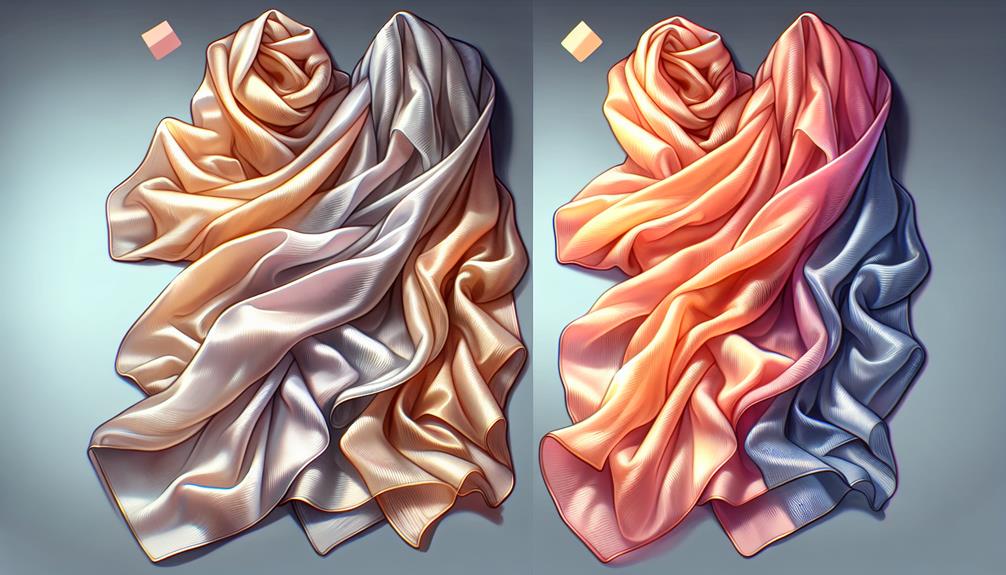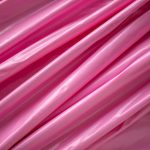To tell if chiffon is silk, first feel its texture. Silk chiffon is super soft, smooth, and warms up quickly when you hold it—unlike synthetic versions that can feel coarse or plasticky. Next, check the luster. Silk has a subtle, luxurious sheen that changes with light, setting it apart from less vibrant synthetics. You can also perform a burn test; silk burns with a smell like burning hair and leaves a fine ash, while synthetics melt into hard beads. Finally, peek at the label; it should say 100% silk for the real deal. There's even more to explore about identifying silk chiffon!
Table of Contents
Key Takeaways
- Feel the texture: Silk chiffon is exceptionally soft, smooth, and warms quickly to body temperature.
- Observe the luster: Silk chiffon has a subtle, luxurious sheen that changes with light and movement.
- Check the fabric label: Ensure it states '100% silk' to confirm authenticity.
- Conduct a burn test: Silk leaves fine, soft ash and smells like burning hair, unlike synthetics which form hard beads.
- Compare prices: Genuine silk chiffon is typically more expensive due to its natural fiber and production costs.
Understanding Chiffon Materials
To really get what chiffon is all about, we first need to look at the different materials it can be made from. Chiffon is typically crafted from silk, polyester, or nylon, but for the high-end stuff, silk is the real deal. Silk chiffon, most notably, is prized for its exceptional softness and slightly textured feel which you can't really get from synthetic materials. This difference is crucial when you're aiming for an outfit with a touch of elegance and flow.
When I'm out hunting for genuine silk chiffon, I keep in mind that it's not just about the feel. Silk as a material has a natural protein structure, making it super absorbent and great for dyeing. This means the colors you find in silk chiffon will often be richer and have more depth compared to those in polyester or nylon chiffon. Also, silk chiffon tends to have a subtle luster that isn't overly shiny, giving it a luxurious look without being too flashy.
Getting to know these material basics is key for anyone looking to master the art of identifying true silk chiffon. It's all about spotting that perfect balance of texture, color depth, and sheen.
The Texture Test
Now, let's talk about how silk chiffon feels to the touch.
I'll show you how to test its smoothness, check its stretchiness, and see how shiny it is.
These simple checks help you figure out if you're really dealing with silk chiffon or something else.
Feel the Smoothness
When you run your fingers across silk chiffon, you'll notice its unmistakable smoothness. This fabric feels luxuriously soft and has a natural sheen that glides under your fingertips.
Unlike synthetic versions, which can feel slightly coarse or plasticky, real silk chiffon has a delicate, almost buttery texture. It's cool to the touch and flows through your hands effortlessly.
If you're trying to determine whether chiffon is silk, pay close attention to how it feels against your skin. Silk tends to warm up quickly to your body temperature, adding to its comfort.
It's these subtle yet distinct characteristics that set silk apart from other materials. Mastering this sensory evaluation will greatly aid in identifying genuine silk chiffon.
Check for Elasticity
Let's move on to testing the elasticity of the fabric to help determine if it's truly silk chiffon. Silk chiffon isn't very elastic. When you pull it gently between your fingers, it shouldn't stretch much. If the fabric springs back like spandex, it's probably a synthetic blend, not pure silk.
Try this simple test: hold a small section and stretch it slightly. Release it and observe how it reacts. Silk chiffon will return to its original shape almost immediately but won't display significant stretchiness. Remember, we're checking for minimal elasticity here. Too much give and quick bounce-back are telltale signs you're not dealing with 100% silk. This step is crucial for confirming the authenticity of your chiffon.
Observe Luster Quality
Moving on to the texture test, you'll notice that silk chiffon typically has a soft, luxurious luster that sets it apart from synthetic alternatives. When you handle it, silk chiffon feels smooth and almost creamy. If you're comparing fabrics, synthetic chiffons often look shinier but in a more artificial, less inviting way.
Silk's sheen, on the other hand, is subtler and has a depth that changes with the light. It's like comparing a glow to a glare. This quality isn't just about looking good; it reflects the fabric's natural origins and the intricate processes it goes through.
Observing the Sheen
Observing the sheen, silk chiffon often displays a subtle, lustrous glow that's quite distinct from other fabrics. When I'm trying to determine whether chiffon is silk or a synthetic alternative like polyester, I always pay close attention to this aspect. The sheen of silk chiffon isn't just shiny; it has a depth that seems to come from within the fabric itself. This quality is due to silk's natural protein structure, which reflects light in a unique way.
As I handle the fabric, I notice how the sheen changes with movement. Silk chiffon tends to have a more fluid, graceful shimmer, whereas synthetic chiffons can appear flatter and more uniform in their shine. It's like comparing the glow of a gentle candle to the glare of a flashlight. Silk's sheen softly diffuses across its surface, enhancing its inherent elegance.
This observation isn't just about looking; it's about seeing. To master this skill, you've got to look at a lot of chiffon. Over time, you'll start to see the subtle differences more quickly. It's a handy trick to have up your sleeve when you're shopping or evaluating your fabric stash. So, next time you're in doubt, just pay attention to the sheen—it tells you more than you might think!
The Burn Test Method
Alright, let's talk about how you can use the burn test to figure out if you've got real silk chiffon.
First, you'll need to safely burn a small piece of the fabric to see what happens.
Then, we'll look at the ash and smell to confirm if it's genuine silk or not.
Conducting the Burn Test
To accurately identify silk chiffon, you can perform a burn test by setting a small sample on fire and observing how it reacts. Here's how you go about it:
- Snip a Small Piece: Cut a tiny piece of the fabric. This should be about 1cm by 1cm. Make sure it's from an inconspicuous area.
- Prep Your Area: Have a non-flammable surface ready, like a ceramic plate or metal tray.
- Light It Up: Use tweezers to hold the fabric piece, then carefully ignite it with a lighter.
- Observe Carefully: Watch how the fabric burns and the type of smell it emits.
This simple test can give you clear clues about the fabric type!
Analyzing the Ash Residue
After completing the burn test, I'll examine the ash residue to determine if the fabric is genuine silk chiffon. Here's what I'm looking for: silk leaves a fine, soft ash that can be easily crumbled between my fingers. It's quite different from the hard, bead-like lumps left behind by synthetic materials like polyester.
If I find that the residue isn't powdery or if it's tough and difficult to break apart, it's likely not real silk. This simple ash test is a great way to quickly spot fakes. Remember, true silk chiffon will always leave behind a delicate ash that feels almost like chalk dust, showing its natural origins.
This step is crucial in verifying the authenticity of your chiffon.
Identifying the Smell
When I perform the burn test, the smell of the smoke can also tell me a lot about whether the fabric is real silk chiffon or not. Here's what I look for:
- Burning Hair Smell: Real silk smells like burning hair when it's set on fire because it's a natural protein fiber.
- No Chemical Odor: Unlike synthetic fibers, silk doesn't give off a harsh chemical smell. If it smells plasticky, it's probably not silk.
- Quick Dissipation: The smell of burnt silk tends to dissipate relatively quickly compared to the lingering, acrid odors of synthetics.
- Mild and Natural: Overall, the odor should be more mild and natural, a clear contrast to any synthetic alternative.
Water Absorption Test
Let's try the water absorption test to see if the fabric is real silk chiffon. It's pretty simple and super effective. All you need is a small water droplet and your fabric sample.
Here's what you do: place a drop of water on the chiffon. Watch closely how it behaves. If it's silk, the water should absorb pretty fast, spreading out swiftly into the fabric. Silk's natural fibers have great absorbency compared to synthetic fibers, which won't soak up the water as quickly.
If the water just sits there on top of the fabric, forming little beads, it's likely not silk. This beading happens because synthetic materials, like polyester, are generally water-resistant. They don't let the water seep through easily.
Price Comparison Insights
Comparing prices can really highlight the difference between genuine silk chiffon and its synthetic counterparts. When I'm out shopping for fabrics, I always keep an eye on the price tags, and here's why: silk is generally pricier due to its natural origins and more labor-intensive production processes. But just looking at the price isn't enough. You've got to know what makes up those numbers. Here's a quick breakdown:
- Production Cost: Real silk involves sericulture, where silkworms are raised specifically for their fibers. This process is more costly than producing synthetic fibers like polyester.
- Texture and Feel: Silk chiffon has a unique, soft, and fluid feel, which is hard to replicate exactly in synthetics. Higher quality often equals higher price.
- Durability and Wear: Silk fibers naturally degrade less quickly than many synthetic fibers, meaning a longer lifespan for your garment.
- Market Demand: Silk is often considered more luxurious and thus holds a higher market value.
When you see a significantly lower price, it's a red flag. Cheap can mean synthetic. I've learned that spending a bit more upfront can save money in the long run due to the durability and timeless style of genuine silk. So, always consider what you're paying for!
Consulting Fabric Labels
Another reliable method to ensure you're getting real silk chiffon is by carefully reading the fabric labels. These tags are your best friends when you're out shopping for authentic materials. They're usually attached at the seam or on the inside of the garment, and they'll tell you exactly what the fabric is made of.
When I'm checking labels, I look for the word 'silk' to make sure I'm not being fooled by synthetic fibers like polyester. These synthetics often try to pass off as the real deal, but they don't offer the same quality or feel. Labels are legally required to list the fiber content, so if it says '100% silk,' you're in the clear. If there's any mention of other materials, it's not pure silk chiffon.
Another tip is to watch out for terms like 'silk blend' or 'silk-like.' These mean the fabric isn't entirely silk and often contains a mix of other fibers. Sticking to labels that confirm 100% silk will save you from disappointment, especially if you're after the genuine luxury and feel of real silk chiffon.
Frequently Asked Questions
Can Silk Chiffon Be Dyed at Home Effectively?
Yes, I've found that dyeing silk chiffon at home is like painting on a delicate canvas—it works, but you've got to be gentle and use the right dyes to avoid damaging the fabric.
How Is Silk Chiffon Washed Without Damaging It?
To wash silk chiffon without damage, I hand wash it gently in cold water with a mild detergent. I don't wring it out; instead, I lay it flat to air dry.
What Sewing Techniques Are Best for Silk Chiffon?
For sewing silk chiffon, I recommend using fine, sharp needles and a straight stitch. It's crucial to handle the fabric delicately to avoid pulls and ensure elegant, professional-looking seams.
Are There Eco-Friendly Alternatives to Silk Chiffon?
Yes, there are eco-friendly alternatives to silk chiffon, like bamboo or banana silk. They're sustainable and still give that lightweight, flowy feel, making them great for environmentally conscious fabric choices in fashion.
How Does Silk Chiffon Impact Sensitive Skin?
I've found that silk chiffon, being a natural fabric, is generally kinder to sensitive skin compared to synthetic materials. It's softer and allows the skin to breathe, reducing irritation and discomfort.
- Is Pure Chiffon Costly? - April 23, 2024
- What Is Similar to Chiffon? - April 23, 2024
- Which Material Is Better Crepe or Chiffon? - April 23, 2024








